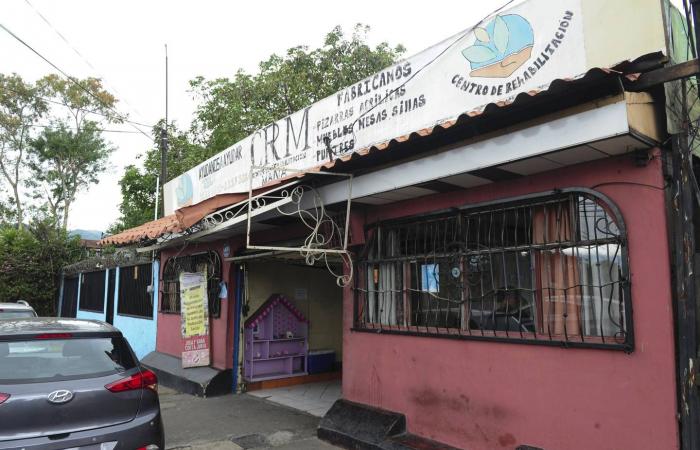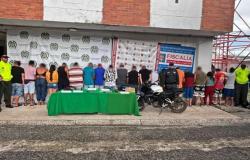In San Sebastián, one of the neighborhoods south of San José, there is a corner where drug addicts end up who, due to their life history, are practically hopeless. Men arrive there who have undergone several hospitalizations without positive results, are burdened with multiple relapses, imprisonment, are unemployed or live on the streets.
They are people who no one believes anymore or who believes very little. For most, the family turned its back, tired of years of problematic consumption, violence or emotional exhaustion. The nine months of treatment that Casa Maná offers them are, for many of them, the last hope to overcome their illness.
The place, as its administrators recognize, does not meet the physical conditions for adequate operation. The infrastructure is an old construction of cement, wood and zinc cans, narrow corridors and high humidity.
There are no classrooms or rooms to receive group therapy, talks of this type take place in a gallery with desks located at the back of the property, to get to that space you must go through a narrow and dark passage. There are also no offices for individual therapies; In its place, “offices” were improvised in small rooms.
Khristopher seeks to quit drugs in his fifth hospitalization
The bedrooms are on the second floor, without a ceiling. There are 26 men living there distributed in 13 cabins. There are no divisions, just a small closet.
Despite these conditions, Casa Maná has the endorsement of the Institute on Alcoholism and Drug Dependence (IAFA) to offer rehabilitation treatment for people with addictions, as it meets the requirements, such as having an interdisciplinary team to care for patients and having a therapy program.
The shortcomings of the place are counteracted by the mystique. The majority of patients do not have to pay for treatment, the organization is financed with donations, contributions from the Social Protection Board, the Mixed Institute of Social Assistance and the sale of desks and blackboards made by the inmates themselves.
“It’s not easy at all,” said Yolanda Barrios, psychologist at the Casa Maná rehabilitation center.
READ MORE: What should I do if a family member is addicted to drugs?
To enter, Barrios said, the person must have a desire for change and have a reference from the IAFA. The treatment is divided into stages and there is at least one psychological, counseling and occupational therapy a month, to think about a work and life plan when leaving the center.
In addition, they must maintain check-ups with IAFA doctors to comply with pharmacological treatment.
One of the people who arrived at Casa Maná months ago is Kristopher González, 28 years old. In February of this year he was about to finish the institutionalization process, it is the fourth time in his life that he has tried it, but relapses always appear.
On February 20, the day we conducted the interview, the young man was in a stage in which he continued living in the center’s facilities, but he went out to work daily, as he found employment thanks to several courses he received through the management of Casa Maná. .
Kristopher did not finish high school and his father is also an addict; He began using tobacco and alcohol as a teenager, he said, to be accepted into “a social group,” then escalated to marijuana, LSD, and alcohol. crack.
“This is my second nine-month rehabilitation process, but I have had three other rehabilitation processes that range from one month to three months,” he commented.
He entered Casa Maná because he is “tired of consumption” and the situations that drugs have made him experience.
“The first time before being admitted I was homeless. I told myself: ‘I can’t be 20 years old and be on the street, I’m too young.’ That impact of seeing myself on the street made me seek help for the first time,” she narrated.
At Casa Maná, people who are going through the rehabilitation process share meal times in the place’s small dining room. (Marvin Caravaca)
He doesn’t know if he will have a relapse, but he assures that this time he has a different feeling, he feels that the blows of life have made him mature and he feels that he has more tools to “get ahead.” For example, in September 2023 he started studying English.
“The desire for acceptance that made me get into drugs is the same thing that made me relapse. Marijuana is something that has been deeply rooted in my life, because that substance is the one that made me feel most included in a social group (…) So, if I use marijuana, that is linked to other substances and that has made me It took a lot to understand it, it’s my Achilles heel,” Kristopher reflected.
READ MORE: More Ticos seek help to get off drugs
Drugs, prison and rehabilitation
Emanuel González, 38, a resident of Desamparados, arrived at Casa Maná in 2020, when he was 34 years old. Currently, he is a graduate of the program who helps other inmates. His consumption began at the age of 12. “At that age I already smoked a cigarette every day and I tried liquor when I was 13,” he said.
Between the ages of 16 and 17 he tried marijuana and cocaine. However, those two substances did not hook him as strongly as tobacco and alcohol.
“When I tried marijuana, I didn’t like its effect. When I tried cocaine I did feel the grip, because the central nervous system is greatly stimulated (…) I think I started using because I had no limits, I grew up in a difficult neighborhood and had a lot of freedom, I spent all day on the street.” Emmanuel recalled.
Emanuel: drugs since adolescence, prison and rehabilitation
Between the ages of 19 and 26, Emmanuel used cocaine as a way to endure the long parties he attended and during which he drank large amounts of liquor. “Then personal situations came and another different stage began,” he said.
From that moment on, he began to use cocaine to relieve anxiety, deal with frustration and calm anger, among other things. Then, he took advantage of a job as a taxi driver to sell cocaine and began using it daily.
“I already consumed it every day and even alone at home, I didn’t need the liquor to consume it (…) I started stealing at bus stops, in the streets, from businesses and they caught me stealing in Alajuela; I was imprisoned for six months. In prison I still consumed, because that is abundant there.”
After cocaine he went to crack which led him to sleep on the streets. “There a sister looked for me to ask me if I wanted help, they told me they were going to make the effort.”
Casa Maná is located in San Sebastián, San José, a rehabilitation center focused on people who are homeless. (Marvin Caravaca)
Among all the things Emmanuel lost to drugs, the most significant is his relationship with his daughter. He’s not even sure how long he hasn’t heard from her, he thinks it’s been ten years since they last saw each other. He only knows that she is 18 and in college.
In 2023 alone, more than 26,000 people sought help to quit drugs at the IAFA, that figure is 28.6% higher than in 2020.







